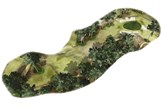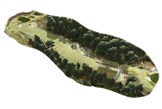US Open 2024: Pinehurst No.2 Course Guide
Published: Last updated:
The 124th US Open will see 156 men attempt to tame one of America’s most demanding tracks. To help mark all our cards, we sought expert insight on all 18 holes…
PINEHURST NO.2 COURSE GUIDE: 1 | 2 | 3 | 4 | 5 | 6 | 7 | 8 | 9 | 10 | 11 | 12 | 13 | 14 | 15 | 16 | 17 | 18
Meet your course guides
Bill Coore – One half of the Coore & Crenshaw design firm, Bill led a $2.5 million restoration of No.2 ahead of the 2014 US Open.
Scott Langley – Former PGA Tour pro turned Senior Director of Player Relations for the USGA. Langley tied for 54th in the 2014 US Open at Pinehurst and will help to set up the No.2 course this year.

Pinehurst’s Major Moments at the US Open
1999 – Four months before his life was cut short in a plane crash, Payne Stewart holed out from 18ft on the final hole to win a thrilling battle against Phil Mickelson. His iconic celebration is memorialized with a statue behind the 18th.
2005 – World No.80 Michael Campbell defied odds of 150-1 to hold off a charging Tiger Woods and secure a two-stroke victory for his only Major title. No player finished under par for the week.
2014 – In a repeat of the 2014 Players, Martin Kaymer dominated from start to finish and thrashed the field by eight shots on nine under par. The German had previously predicted eight over would win it!
Pinehurst No.2 Course Guide
Par 70 | 7,540 yards
Hole No.1:
Par 4 | 395 Yards
2014 average: 4.114 (13)
SL: A pretty straightforward lay-up to start with. You can take driver but the fairway pinches in quite a bit with cross bunkers, so you have to weigh up the risk. The difficulty with the second shot is that you have to be so precise, not just with the target line but the distance as well. I played in four US Opens and Pinehurst was by far the most unrelenting, just because it is so difficult to get the ball close to the hole.

Hole No.2:
Par 4 | 500 Yards
2014 average: 4.339 (3)
SL: This is the signature hole for me, and the hardest green to hit on the course. It’s such a clever design and because the green is angled from front-left to back-right, it really benefits you to drive it down the left side (where the bunkers are) to increase your chances of keeping it on the putting surface. The fall-offs are pretty severe on all sides and there’s also a pronounced hump you have to get over at the front.

Hole No.3:
Par 4 | 387 Yards
2014 average: 3.922 (17)
SL: The decision off the back tee is not too dissimilar to Hole 1. It’s a very simple lay-up with an iron. However, if we do make it driveable – as we did twice in 2014 – there are some forward tees on the right which bring the trees into play up by the green. We can have fun with it, but we also want to present the right risk and reward elements so that if someone does bail out left, they are still faced with a challenging recovery shot. That’s going to guide our decision-making.
BC: If they move the tee up to 305 yards like they’ve done before, you’ve got to carry an area of sand and wire grass and try to thread it in between the bunkers. It’s one of those holes where if you pull it off, it looks incredible. But there’s so much that can go wrong, especially as there’s a drop-off back-right. It’s a fabulous hole to play as a driveable par 4.

Hole No.4:
Par 4 | 528 Yards
2014 average: 4.262 (6)
SL: Another long par 4, played downhill to a relatively generous driving zone, which pitches pretty hard left to right, with bunkers right and a natural area on the left. It’s definitely one of the more receptive greens in its design, with a distinct slope from back-right to front-left.

Hole No.5:
Par 5 | 588 Yards
2014 average: 4.800 (18)
SL: A visually stunning hole with a really cool second shot. It’s reachable in two but you’re playing off a downhill, sidehill lie and hitting uphill to the green. The best place to miss is on the right but there’s also an awkward ridge, running from front-right to back-left, which makes it difficult to gauge the pace of the green.
BC: No.5 plays to a very tilted fairway which is really hard to hit while avoiding the wire grass on the left. If you don’t, you’re hitting off a canted lie, which obviously encourages a right-to-left shot, to a green which is not at a receptive angle. The green is a bit like hitting your ball onto a hot dog bun; it’s crowned off side-to-side and generally the pins are in a straight row, all the way down the green. On the left side it falls dramatically down a 10ft bank to some sandy rough, so that only leaves a little area to the right of the green because you don’t want to go long or short.

Hole No.6:
Par 3 | 216 Yards
2014 average: 3.374 (1)
SL: The first and longest of the par 3s on the course. We will appropriately manage the firmness because this is a tough tee shot to bounce the ball in and get over a pretty severe front slope. There is a level section on the right side, but you can see why there were only 12 birdies here in 2014. There are deep bunkers either side and it falls away on the back part of the green with a false edge.

BC: Boy, is this difficult. There are some tall pines left and right and if the wind is blowing, it can really swirl in the trees, a bit like No.12 at Augusta. The green is kind of deep but not particularly wide, with a big swale front-left in the fairway. It’s probably six feet deep and any ball that lands there doesn’t bounce forward. It just comes straight back. If you miss the bunkers on the left or right, you’re in the sandy rough trying to play over a bunker. It’s such an elusive target and it can be extremely fast putting from the back of the green to the front.

Hole No.7:
Par 4 | 426 Yards
2014 average: 4.143 (11)
SL: This is a sharp dog-leg right, with bunkers on the inside corner and natural areas all along the left-hand side. For players thinking about cutting the corner, they’ll have to navigate some risk to avoid running out of fairway.

Hole No.8:
Par 4 | 492 Yards
2014 average: 4.336 (4)
SL: One of the more challenging holes on the front side. It slopes really hard right-to-left in the drive zone, which means you need to hug the right-hand side to avoid running through the fairway. The putting green tilts back to front with a bail-out zone right and a significant drop-off long and left. The back portion probably has the most severe fall-off on the entire course.

Hole No.9:
Par 3 | 184 Yards
2014 average: 3.078 (14)
SL: A visually stunning par 3. The green is divided by two sections: rising from front-right to back-left, and bisected by a pretty significant ridge. Long and left are the worst places to miss it.

Hole No.10:
Par 5 | 617 Yards
2014 average: 4.998 (16)
SL: The longest hole on the course, though we will still have a few guys reaching it in two. It’s a pretty inviting driving zone, but you can’t really see the green for the second shot so you’re picking your target line and hoping it works out. It does fall away quite significantly at the back, so that presents some pretty tough pitching options.

Hole No.11:
Par 4 | 478 Yards
2014 average: 4.323 (5)
SL: This is a beautiful hole, bordered by native areas which keep you honest. It’s probably a driver, mid-iron to the green, which has a decent false edge on the back-left corner. There are some tough left-side pin locations we can use as well, which will be difficult to access.

Hole No.12:
Par 4 | 486 Yards
2014 average: 4.233 (8)
SL: For the 12th, we actually use a tee on the No.4 course at Pinehurst. The green is really interesting because it’s not super wide and the left side doesn’t really exist. It just kind of falls away into a fringed collection area, which is where you’ll see a lot of balls. There’s also a false front and another drop-off behind, so the margin for error is pretty small.

Hole No.13:
Par 4 | 381 Yards
2014 average: 4.004 (15)
SL: We’re tossing around the idea of pushing the tee up. We’ve narrowed the fairway slightly, just to enhance the difficulty of a lay-up from the regular tees, but you might see some players hitting driver regardless. Most of the trouble is at the front of the green, so this is the one hole where it’s better to be slightly long than short.
BC: The green pitches hard back to front and sits up on a plateau, so you can’t really see much of the putting surface with an approach from the fairway. If you’re going for it and land 20 yards short of the green, there are no guarantees it is going to get up there. The front of the green folds over towards you and there are some pretty nasty bunkers on the right as well. It’s a classic example of how precise you need to be.

Hole No.14:
Par 4 | 472 Yards
2014 average: 4.141 (12)
SL: This is the beginning of a really strong closing stretch. It’s an iconic and generous driving hole, framed nicely with bunkers on both sides. The play is to the front portion of the green, because it drops away severely at the back and even more so on the left and right. There’s also a pronounced slope from back to front, so it’s a very Pinehurst No.2 hole in its look and design.

Hole No.15:
Par 3 | 199 Yards
2014 average: 3.256 (7)
SL: A slightly shorter version of No.6. There’s a very pronounced false edge on the front part of the green and again it falls off on all sides. The surrounds are tough to recover from, because of the severity.

Hole No.16:
Par 4 | 536 Yards
2014 average: 4.341 (2)
SL: This is an absolute brute. The pond isn’t in play off the tee, so players will be hitting driver down the left side, setting up a long iron into the smallest – and possibly flattest – green on the course.

BC: This plays as a par 5 for members and their guests, but it will play as a par 4 for the Championship. Again, the green folds away from the center, and even if you avoid the front crown, it then starts to drift away towards the back. It all looks very calm, but any shot that lies just past the middle of the green is very likely to run off, possibly into a back bunker, which is rare for Pinehurst.

Hole No.17:
Par 3 | 207 Yards
2014 average: 3.209 (9)
SL: Another great setting and similar in length to the 15th, so we’ll be adjusting the tee boxes to provide good variety on those two holes. The green sits in a bit of a bowl but it does present some challenging hole locations, based on the club players will be approaching the green with.
BC: Another green that is propped up in the air and falls off on almost all the edges. It’s also not a circular green, it’s a bit of a puzzle piece that lends itself to pins which are very hard to access.

Hole No.18:
Par 4 | 448 Yards
2014 average: 4.202 (10)
SL: This is an iconic finishing hole with a gentle movement to the right. The fairway pinches in the further up you go and the green falls off moderately on all sides. It gives us a lot of great options for hole locations.
BC: Pinehurst is quite flat but this hole plays to a fairway which staggers and zigzags all the way. The tee shot must carry up onto a plateau which is defended by a huge, deep bunker where you have zero chance of getting on in two. The green is angled towards the right side of the fairway but it’s well defended with a cross bunker, 10 yards short of the green, and some fierce and seriously demanding contours.

SUBSCRIBE TO TODAY’S GOLFER: Print and Digital access, discounts and rewards!
About the author

Michael Catling
Features Editor
Michael Catling is Today’s Golfer‘s Features Editor and an award-winning journalist who specializes in golf’s Majors and Tours, including DP World, PGA, LPGA, and LIV.
Michael joined Today’s Golfer in 2016 and has traveled the world to attend the game’s biggest events and secure exclusive interviews with dozens of Major champions, including Jack Nicklaus, Jordan Spieth, Tom Watson, Greg Norman, Gary Player, and Justin Thomas.
Get in touch with Michael via email and follow him on Twitter.
-
 US Open 2024: Pinehurst No.2 Course Guide
US Open 2024: Pinehurst No.2 Course Guide
-
 Your Pinehurst No.2 course guides - Bill Coore (left) and Scott Langley
Your Pinehurst No.2 course guides - Bill Coore (left) and Scott Langley
-
 Pinehurst Hole 1
Pinehurst Hole 1
-
 Pinehurst Hole 10
Pinehurst Hole 10
-
 Pinehurst Hole 11
Pinehurst Hole 11
-
 Pinehurst Hole 12
Pinehurst Hole 12
-
 Pinehurst Hole 13
Pinehurst Hole 13
-
 Pinehurst Hole 14
Pinehurst Hole 14
-
 Pinehurst Hole 15
Pinehurst Hole 15
-
 Pinehurst Hole 16
Pinehurst Hole 16
-
 Pinehurst Hole 17
Pinehurst Hole 17
-
 Pinehurst Hole 18
Pinehurst Hole 18
-
 Pinehurst Hole 2
Pinehurst Hole 2
-
 Pinehurst Hole 3
Pinehurst Hole 3
-
 Pinehurst Hole 4
Pinehurst Hole 4
-
 Pinehurst Hole 5
Pinehurst Hole 5
-
 Pinehurst Hole 6
Pinehurst Hole 6
-
 Pinehurst Hole 7
Pinehurst Hole 7
-
 Pinehurst Hole 8
Pinehurst Hole 8
-
 Pinehurst Hole 9
Pinehurst Hole 9
-
 The par-4 16th hole usually plays as a par-5 for members
The par-4 16th hole usually plays as a par-5 for members
-
 The par-3 sixth hole is was the toughest in 2014
The par-3 sixth hole is was the toughest in 2014
